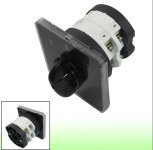Hello,
I am running cyclone motor with a 48v 20ah battery, I am planning on getting another additional battery sometime in the near future.
I am using the triangle bags for both and would like to have both on bike at same time, as it would be a real pain removing either battery or taking the bags off.
I have been thinking alot about running 2 batteries, and migh run them parallel, but dont really want to get another 48v, and not sure if I would want to spend the money to get 2 new higher voltage batteries or even 1 BIG battery.
Playing with the idea in my head of just getting like a 60v or maybe even 72 volt for this bike AND having it wired on the bike with the 48v also still in play.
I am sure that I could somehow wire up a switching system that would make it really easy to switch from one battery to the other. Anyone done this?
As the bike is set up now it would be a real pain to have to disconnect one battery and connect a different one manually,,, The idea of just using a switch to switch back and forth is ideal, looking for ideas...if anyone can help....
Thanks
J
I am running cyclone motor with a 48v 20ah battery, I am planning on getting another additional battery sometime in the near future.
I am using the triangle bags for both and would like to have both on bike at same time, as it would be a real pain removing either battery or taking the bags off.
I have been thinking alot about running 2 batteries, and migh run them parallel, but dont really want to get another 48v, and not sure if I would want to spend the money to get 2 new higher voltage batteries or even 1 BIG battery.
Playing with the idea in my head of just getting like a 60v or maybe even 72 volt for this bike AND having it wired on the bike with the 48v also still in play.
I am sure that I could somehow wire up a switching system that would make it really easy to switch from one battery to the other. Anyone done this?
As the bike is set up now it would be a real pain to have to disconnect one battery and connect a different one manually,,, The idea of just using a switch to switch back and forth is ideal, looking for ideas...if anyone can help....
Thanks
J





